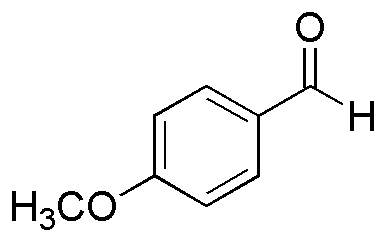p-Anisaldehyde is widely utilized in research focused on:
- Fragrance and Flavor Industry: This compound is commonly used in perfumes and flavorings due to its pleasant, sweet aroma. It enhances the scent profiles of various products, making it a popular choice among fragrance manufacturers.
- Pharmaceuticals: p-Anisaldehyde serves as an important intermediate in the synthesis of various pharmaceuticals. Its unique chemical properties allow for the development of compounds with specific therapeutic effects, aiding in drug formulation.
- Organic Synthesis: In organic chemistry, it is often employed as a building block for synthesizing more complex molecules. Researchers utilize it to create derivatives that can be used in various chemical reactions, streamlining the synthesis process.
- Analytical Chemistry: This compound is used as a reagent in analytical methods, such as chromatography. It helps in the identification and quantification of various substances, making it essential for quality control in laboratories.
- Polymer Industry: p-Anisaldehyde is also used in the production of certain polymers and resins. Its incorporation can enhance the properties of the final product, such as stability and durability, which is crucial for various applications.
General Information
Properties
Safety and Regulations
Applications
p-Anisaldehyde is widely utilized in research focused on:
- Fragrance and Flavor Industry: This compound is commonly used in perfumes and flavorings due to its pleasant, sweet aroma. It enhances the scent profiles of various products, making it a popular choice among fragrance manufacturers.
- Pharmaceuticals: p-Anisaldehyde serves as an important intermediate in the synthesis of various pharmaceuticals. Its unique chemical properties allow for the development of compounds with specific therapeutic effects, aiding in drug formulation.
- Organic Synthesis: In organic chemistry, it is often employed as a building block for synthesizing more complex molecules. Researchers utilize it to create derivatives that can be used in various chemical reactions, streamlining the synthesis process.
- Analytical Chemistry: This compound is used as a reagent in analytical methods, such as chromatography. It helps in the identification and quantification of various substances, making it essential for quality control in laboratories.
- Polymer Industry: p-Anisaldehyde is also used in the production of certain polymers and resins. Its incorporation can enhance the properties of the final product, such as stability and durability, which is crucial for various applications.
Documents
Safety Data Sheets (SDS)
The SDS provides comprehensive safety information on handling, storage, and disposal of the product.
Product Specification (PS)
The PS provides a comprehensive breakdown of the product’s properties, including chemical composition, physical state, purity, and storage requirements. It also details acceptable quality ranges and the product's intended applications.
Certificates of Analysis (COA)
Search for Certificates of Analysis (COA) by entering the products Lot Number. Lot and Batch Numbers can be found on a product’s label following the words ‘Lot’ or ‘Batch’.
*Catalog Number
*Lot Number
Certificates Of Origin (COO)
This COO confirms the country where the product was manufactured, and also details the materials and components used in it and whether it is derived from natural, synthetic, or other specific sources. This certificate may be required for customs, trade, and regulatory compliance.
*Catalog Number
*Lot Number
Safety Data Sheets (SDS)
The SDS provides comprehensive safety information on handling, storage, and disposal of the product.
DownloadProduct Specification (PS)
The PS provides a comprehensive breakdown of the product’s properties, including chemical composition, physical state, purity, and storage requirements. It also details acceptable quality ranges and the product's intended applications.
DownloadCertificates of Analysis (COA)
Search for Certificates of Analysis (COA) by entering the products Lot Number. Lot and Batch Numbers can be found on a product’s label following the words ‘Lot’ or ‘Batch’.
*Catalog Number
*Lot Number
Certificates Of Origin (COO)
This COO confirms the country where the product was manufactured, and also details the materials and components used in it and whether it is derived from natural, synthetic, or other specific sources. This certificate may be required for customs, trade, and regulatory compliance.


